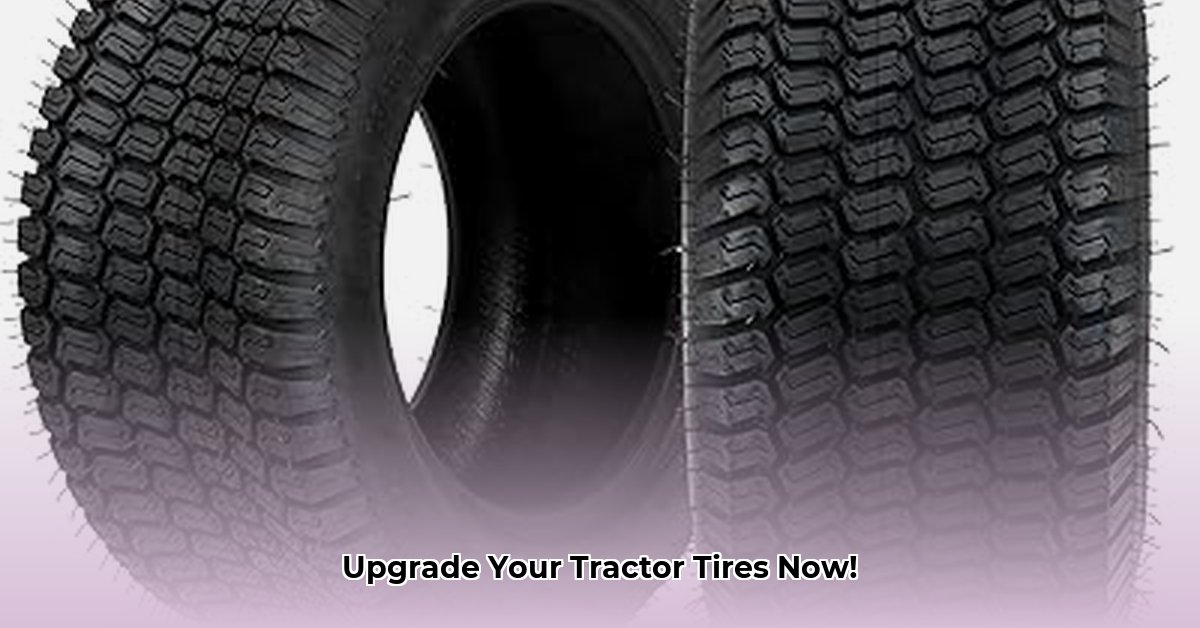
Choosing the right tractor tires significantly impacts farming efficiency and environmental sustainability. The 18x8.5x10 size is popular, and understanding its role in sustainable agriculture is crucial. This guide provides actionable advice for selecting and maintaining these tires for optimal performance and minimal soil compaction. We will delve into tire pressure, tread patterns, and key factors to consider for a more sustainable farming operation. For more information on various tractor tire sizes, see this helpful resource.
Understanding Your 18x8.5x10 Tractor Tires: More Than Meets the Eye
The 18x8.5x10 tire size isn't just a number; it directly influences soil health, fuel consumption, and ultimately, your farm's profitability. Selecting the correct tire significantly impacts sustainable farming practices. Improper tire selection contributes to soil compaction, leading to reduced yields and increased operational costs.
Tire Pressure: The Key to Soil Health and Fuel Efficiency
Tire pressure is critical. Underinflation leads to excessive soil compaction, while overinflation increases the risk of tire damage. Maintaining optimal pressure is paramount.
Don't underestimate the impact of proper tire inflation! Is consistent pressure monitoring part of your routine? A properly inflated 18x8.5x10 tire distributes weight effectively, minimizing soil compaction. "Regular pressure checks are essential," states Dr. Emily Carter, Agricultural Engineer at the University of California, Davis. "Underinflation is a common oversight with significant consequences for soil health and fuel efficiency."
Optimal Tire Pressure: Consult your tractor's manual and tire manufacturer's recommendations for the precise pressure suitable for your specific load and terrain. Consider investing in a tire pressure monitoring system (TPMS) for automated monitoring and alerts.
Tread Patterns: Matching Grip to Terrain
Different tread patterns are designed for varying soil conditions. Aggressive treads excel in harsh terrain but may increase soil disturbance. Smoother treads minimize compaction but may compromise grip in wet or muddy conditions.
Tread Pattern Selection: Analyze your typical working conditions. What soil type do you predominantly work with? What is your typical rainfall? Does your land have steep slopes? Choose a tread pattern that balances traction and minimal soil disturbance based on these factors.
Picking the Perfect 18x8.5x10: Key Considerations
Choosing the right 18x8.5x10 tire involves assessing several factors:
- Soil Type: Sandy soils are more prone to compaction than clay soils. Tire selection should account for this variance.
- Farming Practices: No-till farming requires tires designed to minimize soil disturbance.
- Climate: Wet conditions necessitate tires with superior drainage to prevent waterlogging.
- Budget: While higher-quality tires might involve a higher initial investment, their extended lifespan can lead to long-term cost savings.
Keeping Your Tires in Top Shape: A Maintenance Guide
Regular maintenance extends tire lifespan and maximizes performance.
- Regular Inspections (Weekly): Inspect tires for cuts, punctures, and uneven wear. Early detection prevents major issues.
- Tire Rotation (Every 50 Hours): Rotate tires to ensure even wear, extending their lifespan. Consult your tractor's manual.
- Cleaning (After Each Use): Remove mud, rocks, and debris to prevent damage and maintain optimal performance.
- Proper Storage (During Off-Season): Protect tires from sun damage and cracking during periods of inactivity.
The Big Picture: Sustainability and Your 18x8.5x10 Tires
Sustainable farming requires minimizing soil compaction. Proper tire selection and maintenance directly influence soil health, water infiltration, and overall farm productivity. Reduced soil compaction translates to long-term benefits including:
- Increased water retention.
- Improved plant growth and yields.
- Lower soil erosion.
Weighing the Pros and Cons: Is an 18x8.5x10 Right for You?
| Pros | Cons |
|---|---|
| Reduced soil compaction | Higher initial cost compared to smaller sizes |
| Improved fuel efficiency | May not be ideal for all terrains |
| Enhanced traction in many conditions | Requires diligent maintenance |
| Significant contribution to sustainable practices | Potential for increased wear in specific situations |
How to Choose Sustainable Tractor Tires for Reduced Soil Compaction: A Step-by-Step Guide
- Assess Your Needs: Determine your tractor's weight and typical loads. Different operations necessitate different tire specifications.
- Evaluate Tire Technologies: Research the benefits of Increased Flexion (IF) and Very High Flexion (VF) tires, along with Low Sidewall (LSW) options.
- Check Inflation Pressure Regularly: Underinflation leads to compaction and tire damage. Overinflation increases wear. Always use a reliable pressure gauge.
- Understand Your Soil Type: Consider the specific properties of your soil to prevent compaction.
- Weigh the Long-Term Costs: Sustainable tire options often offer long-term cost savings despite higher initial investments.
- Proper Tire Maintenance: Regular inspections and preventative maintenance extend tire lifespan and overall farm sustainability.
[1] Michelin Agricultural Tires: Reducing Soil Compaction. https://business.michelinman.com/tips-suggestions/reducing-compaction